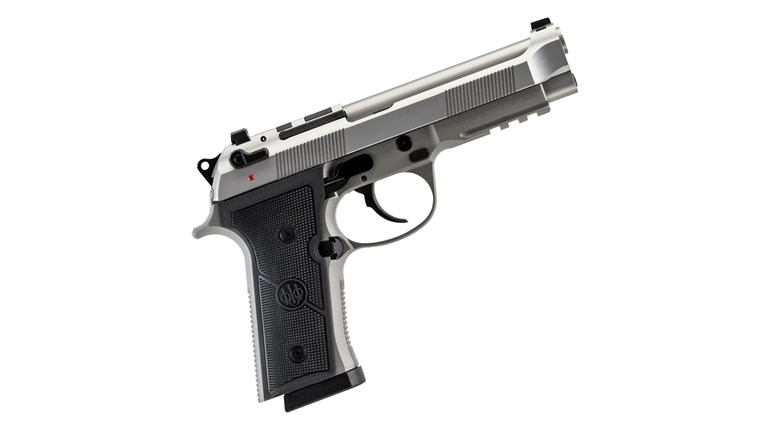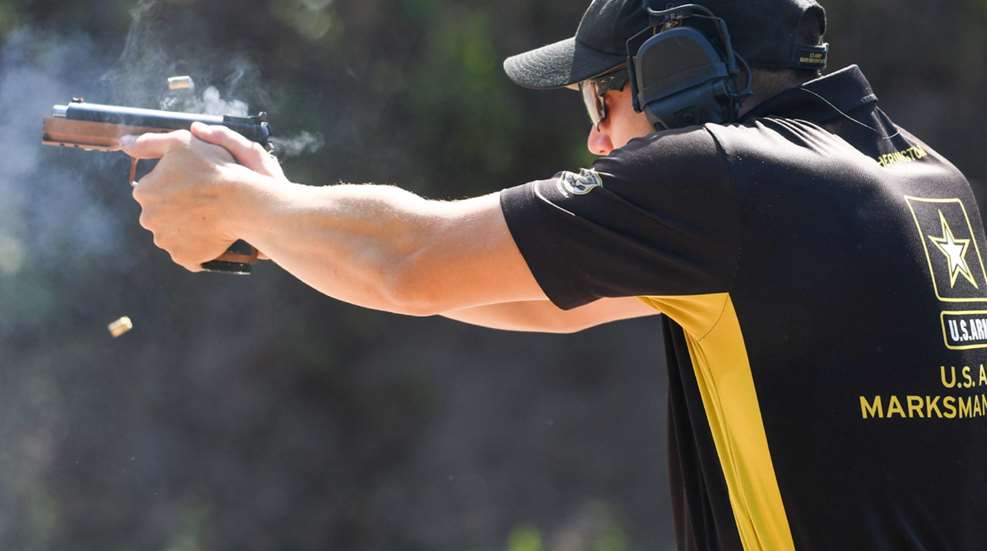
For 2020, the USPSA Back to Back Events Sponsored by SIG returned to Universal Shooting Academy in Frostproof, Fla., and were split into the Factory Gun and Race Gun Nationals.
Factory Gun was the first event, featuring Carry Optics and Production divisions, with each shot over three day . Preceding both matches was a two-day staff match, something new for 2020. Normally, staff members are presented with the “work one, shoot one” option that requires them to get a slot for the match, pay for it, and be available for the entire time of both matches. I wanted to try something different and give the staff the option to work and shoot one instead, as well as provide them with a free slot to that match. This would require less time donated by them, since it would only be two days for the staff match and three days for the remaining competition. There were over 70 staff who signed up to shoot the Factory Gun Match, and many were new faces to work at Nationals, which was the goal.
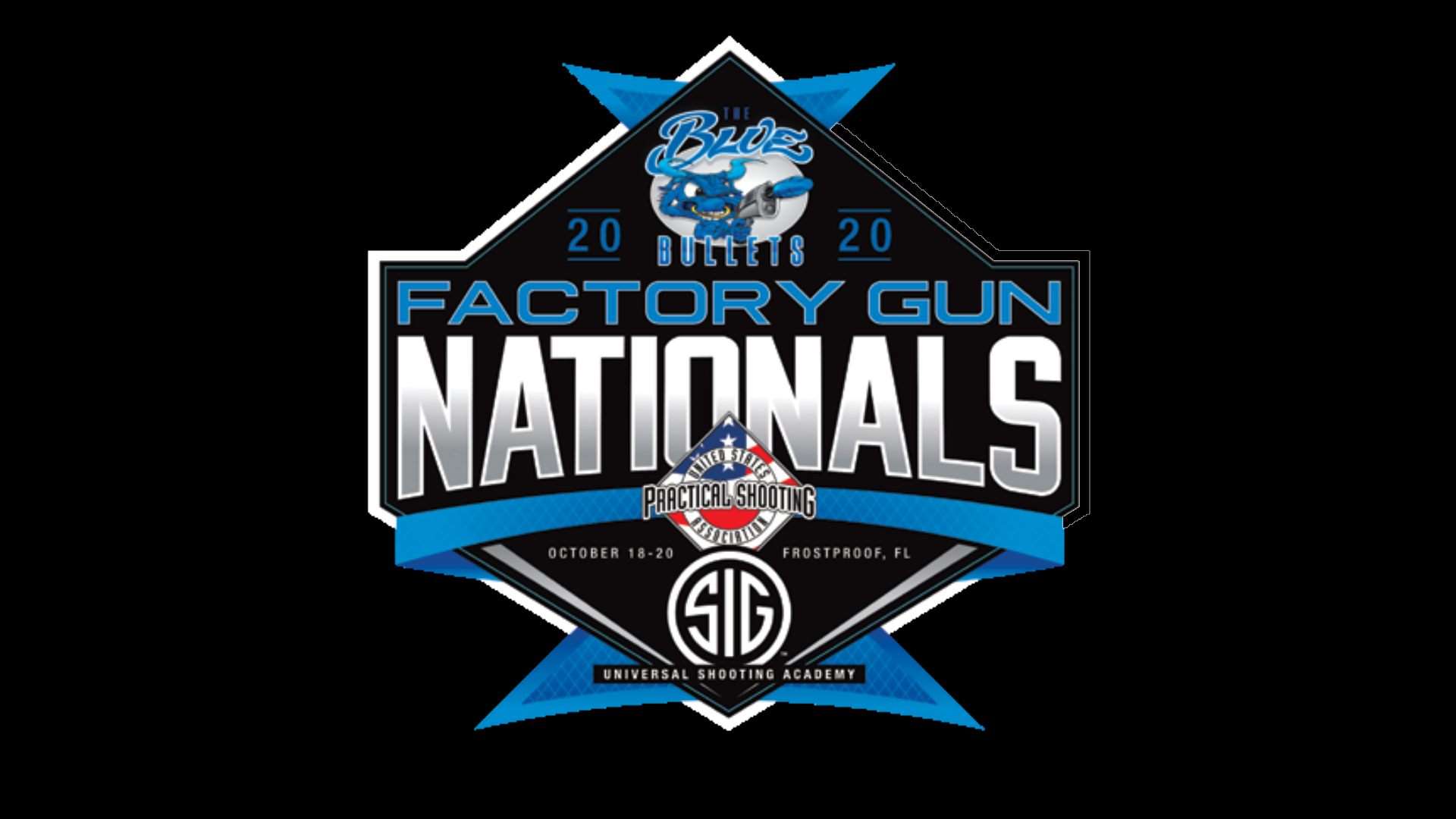
Match staff kicked off the Factory Gun Match sponsored by Blue Bullets on Friday, Oct. 16, and would complete the 22-stage match on Saturday, Oct. 17. It is a lot to shoot 11 stages a day; however, the flow of the match worked out and the staff were done way ahead of the scheduled time. After cleaning up the stages, repainting start positions, and repairing any unnecessary holes the first group of shooters left behind the next three days saw morning and afternoon flights of competitors work their way through the 22 stages. Each stage required 488 rounds to complete. Each day the squads of no more than 12 competitors would shoot in one of the three zones that would require six stops. In each of the zones there were bays that had doubled up stages to challenge the competitors.
Zone 1 had stages 1 through 7, as well as the stop at the chronograph to test shooter ammunition and check equipment. The seven stages comprising Zone 1 required 158 rounds. There were four long field courses in this zone, as well as a Standard stage and two Speed Shoots, one of which was being qualified as a new classifier candidate. Stage 1 “After Midnight” was a 28-round stage that was set in the Universal Shooting Academy Shoot House. With an up-range start on the right-hand side of the bay, competitors would have to retreat, backing up into a low port after engaging the target arrays at the start. Depending on your chosen division and the capacity restrictions in Production, this was going to push shooters to decide what targets were going to need to be shot from the start, as several of the further downrange targets were going to be available from another position. Once working your way to the low port and taking the required shots at the targets that were only available from there, competitors were presented with another port on the left side of the Shoot House to engage at least one target that was only available from that position. From there you charged forward into the house where there were at least two stops for target arrays on both the right and left before finishing at the end position for the remaining targets placed outside of the house. It was easy to misstep here and pass up the required positions in the house, as well as add some extra holes into targets outside that were already shot from the start. Sal Luna would take the first stage win in Production with an overall time of 19.01 with 132 of the 140 possible points. The battle in Carry Optics started off seeing new name grab an early stage win with Trace Decker hitting 134 points in 18.98 seconds.
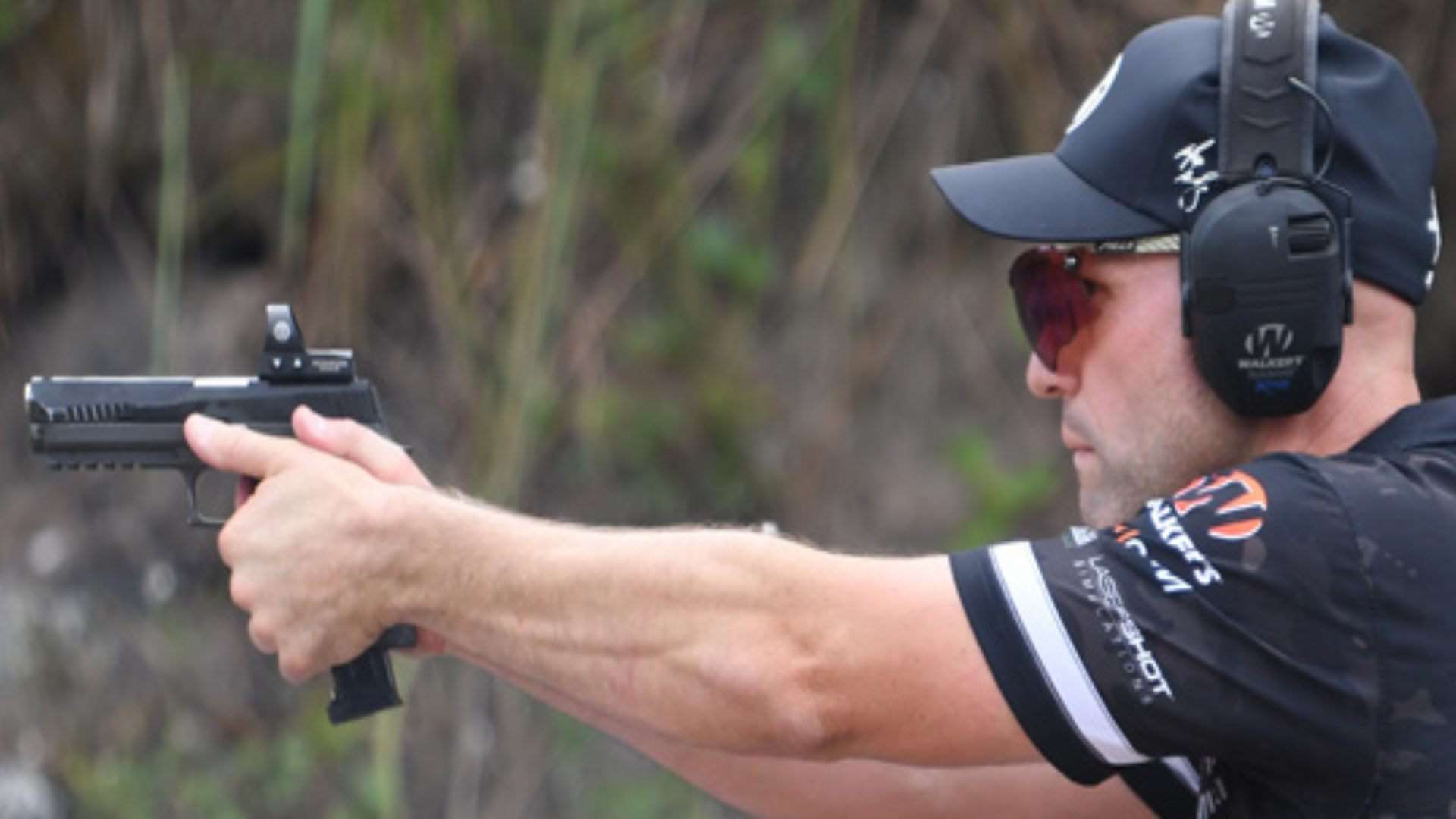
Stage 2 “Running to Stand Still” turned out to be an appropriate name for this 26-round stage that many called a memory stage. All stages are memory stages to some degree, but this one required a start in the middle of the moon-shaped shooting area, as well as going to each of the far ends to engage the 13 targets. Yes, you could shoot a couple of them a few times from several different spots, and yeah there were some tucked back that could only be seen from certain other spots, but part of the game is being able to break a stage down. Oh, and the targets were at “a little bit of distance” as well, but being able to shoot at distance is also part of the game. There were not a lot of competitors who came away with no misses on this stage; Russell Maskey in Production was one that did for a stage win. Jeff Emrich made use of the dot in Carry Optics, shooting 116 of the 130 points in 19.08 for a stage win.
After a choppy first stage and “memory” stage with some longer shots, competitors moved on to Stage 3, “Come On Let’s Go.” This was the battle cry for some top competitors, as they had not performed too hot on the first two stages. This was another field course requiring 30 rounds for competitors to work their way through. It was a fun stage with lots of options on how to shoot it, but every competitor was going to have to make it to at least four different shooting positions, with the options of some longer shoots or shooting on the move. U.S. Army Marksmanship Team shooter Jacob Hetherington showed up here, with 144 points of the available 150 in 20.22 seconds. This was not the fastest time, but he didn’t mess around when it came shooting As on this stage. The top Carry Optics guys were still in a different time zone and hadn’t woken up, as Shannon Smith slid past them with a stage win, also shooting 144 points in 19.89 seconds. Smith said that this was one of his favorite stages of the match—probably because of the stage win.
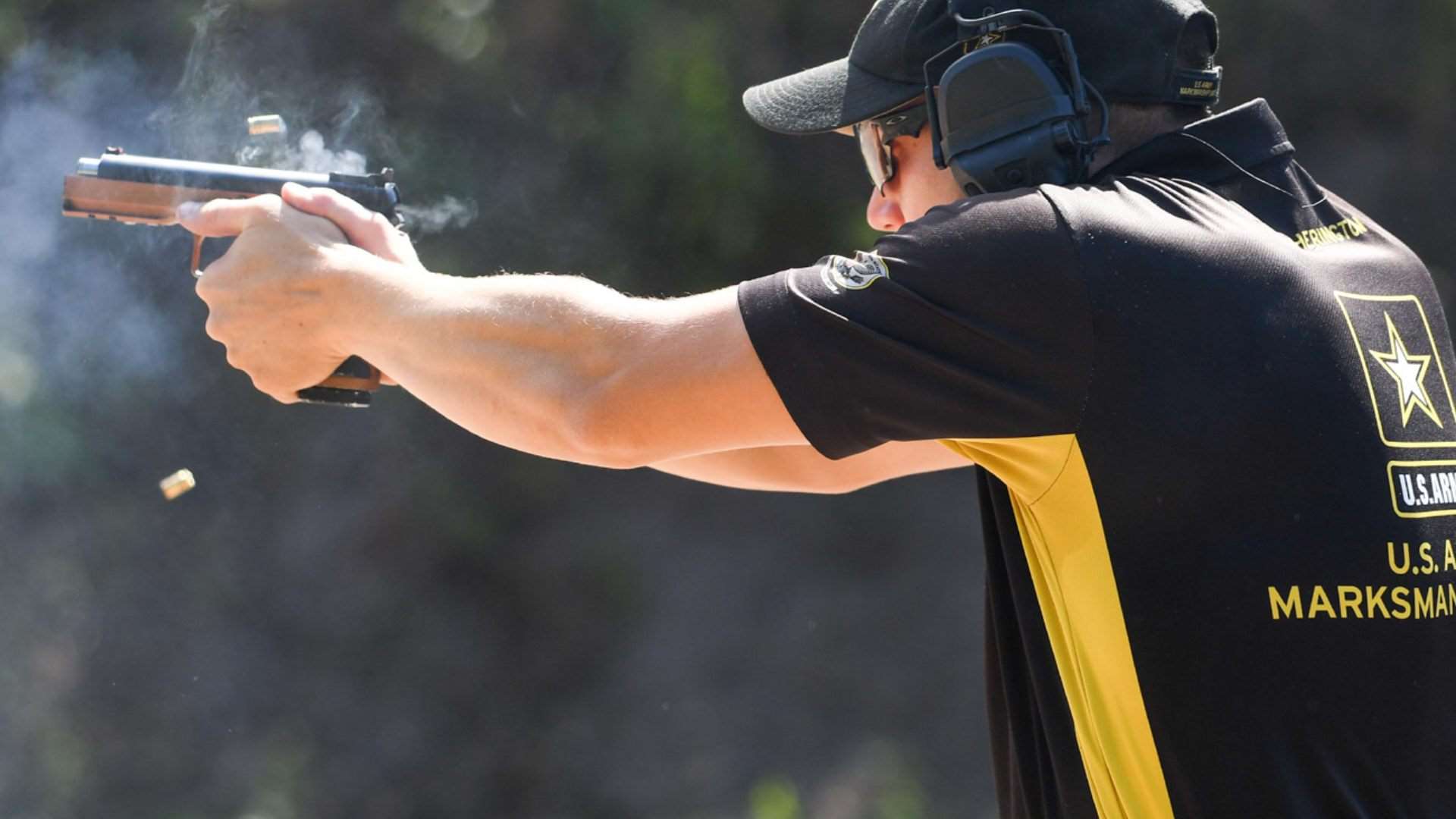
After three long courses that were not easy, competitors got a break with a Standards Stage for Stage 4 “Don’t Cry.” This was a straightforward Par Time stage with two strings shot from two boxes, one at 20 yards and the other 15 yards—three targets downrange, engaging the center target T2 with only four rounds, reload and engage T1 and T3 with only four rounds each in eight seconds. This sounds much harder than it appears to be, but when you break it down, it is a very doable stage to get all your shots off. If your draw and first shot is 1.50 seconds, and the reload is two seconds, that leaves six shots in 4.5 seconds, actually 4.80 seconds because you get .30 seconds before it is counted as an overtime shot. You are only scored on the hits you make on this stage. The second string was moved up to the closer box and required two rounds per target with a mandatory reload, then into strong-hand only for the remaining two rounds per target, also in eight seconds. Again, this is a total points stage; as long as you don’t have overtime shots or extra hits on the targets, you are only scored on the hits you have. David Miller shot 97 of the available 120 points in Production, and Luigi Li with 106 points in Carry Optics took stage wins on this one.
The next bay in Zone 1 had Stages 5 and 6 together. Stage 5, “The Way You Make Me Feel,” is now the Classifier 20-02. This stage was initially shot at the Classic Nationals, and is a quick 12-round stage with two targets on the right, two in the center section and two on the left. Competitors can start anywhere in the shooting area. Each array of targets also has one no-shoot on the target closest to the vision barrier. With quick side-to-side movement, this stage as a classifier represents more of what we do on a course of fire than the “stand and deliver” type of classifiers we are used to shooting. Brantley Merriam snuck a stage win here in Carry Optics and he would also finish up High B Class at the end of the match. Something that you don’t see too often was J.J. Racaza and Jacob Hetherington both getting a 11.1753 hit factor, both shooting 58 of the 60 points in the same 5.19 time.
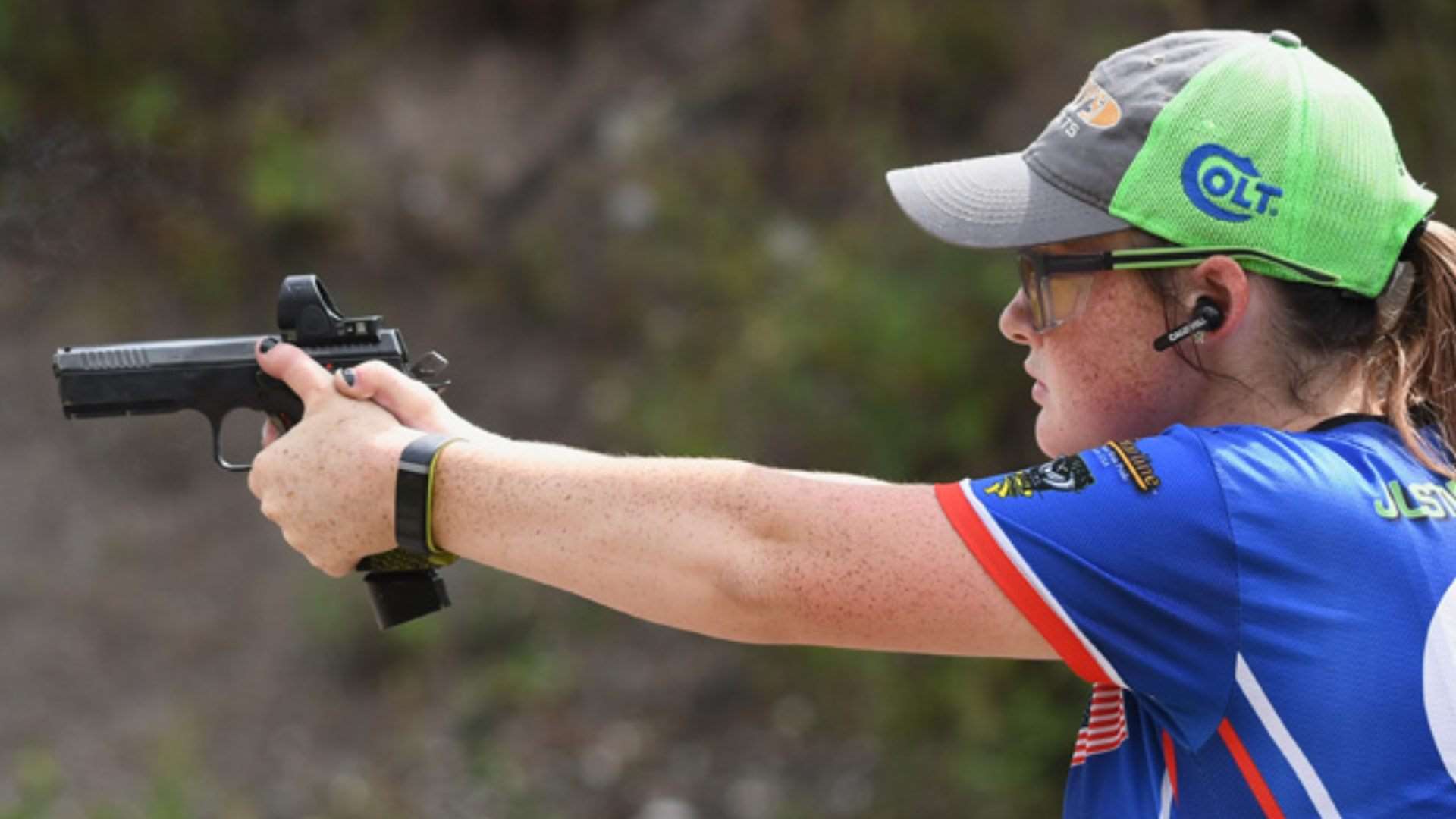
The stage that shared this bay, Stage 6, “Hard to Handle,” gave competitors the choice of shooting either the three cardboard targets or the six poppers freestyle, reload and engage whatever they didn’t shoot on the turn and draw was now shot strong-hand only. Most competitors opted to shoot the cardboard which had no-shoots on the outside targets and hard cover on the center to avoid the penalties, and strong hand on the steel. Micah Swan lead the way with a stage win in Carry Optics by cleaning this stage, shooting all 60 of the available 60 points in 8.11 seconds, and Hetherington took another stage win here as well.
Stage 7 “Life in the Fast Lane” finished out Zone 1, and was the first stage in this zone with an activated target with its fast-moving swinger. A start in the center of the stage with targets spread out with a mixture of up close cardboard, which included two low targets through a port on the left side. There were also four poppers, with one activating the swinger on the far-right side that could be taken from several positions. This was another stage with lots of options, and saw many different plans on how to shoot the required 26 rounds. Max Michel grabbed his first stage win here in Carry Optics to finish out his first day of competition. And Hetherington crushed the rest of the Production field with a 15.94 second run, shooting 116 of the 130 stage points for another stage win.
Zone 2 had stages 8 through 15 with 160 rounds needed and was going to bring in a lot more activated targets—plus, two more of these stages were also being vetted as new classifiers. This time there were two bays with doubled-up stages on them as well, which meant that this zone had eight stages presented for the competitors. “Sultans of Swing” kicked off this zone on Stage 8, a 32-rounder that had a swinger and bobber, both activated by separate poppers. This stage took advantage of the bay’s depth, making shooters work their way downrange engaging targets. There were lots of different plans that were tried on how to work through the middle section of the stage and the best order to engage the poppers that activated the swinger and bobber targets. The second day of shooting had Mason Lane take his first stage win here in Production, edging out Nils Jonasson by only 0.35 second, with both shooting 146 points. The Carry Optics Super Squad of shooters was still off the pace, and Jason Bradley grabbed a stage win with a 15.68-second run over Max Michel’s 15.74—both shooting 152 points of the available 160.
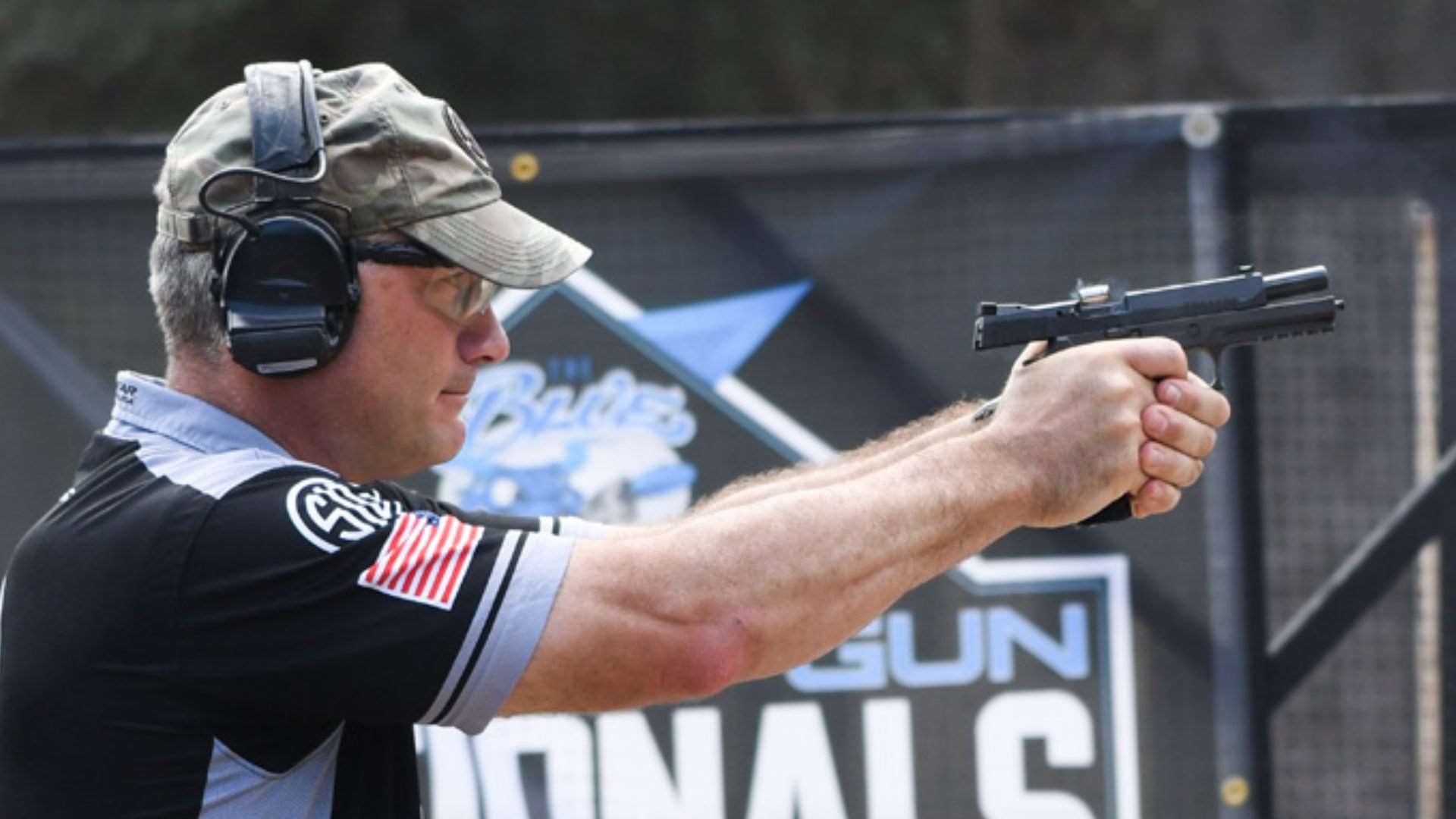
“Ain’t That a Shame” was a double-swinger stage requiring only 20 rounds, and designed to answer that shorter course, IPSC-style stage. Eight IPSC targets and four poppers were engaged with a start on the forward downrange fault line. This required quick reloading for the Production competitors with their 10-round capacity, as they backed into the second position. It also meant that they would need to go one-for-one on the steel, as they only had one make-up round if they tried for the 10 shots at the start. Backing into the second position opened up two targets on the left side of the bay, and then a hard transition into the right with two targets angled through a vision barrier and ending on a solo target on the right side. I borrowed this stage idea from an IPSC Extreme match, and moved stuff around a little to use for this match. Max Michel was starting to come alive now, grabbing only his second stage win in the first nine stages of the match. Mason Lane grabbed another stage win here over Jacob Hetherington; both shot it in 11.90 seconds, but Lane’s 88 points edged out Jacob’s 86.
The next bay doubled up two stages. The first was Stage 10, designed by Bill Wittman for his CRO course, and I decided to make it a new classifier. “Wish You Were Here” was a 12-rounder with a start in the center that included five cardboard and two poppers. The outside targets were the same on both the right and left with one cardboard and one popper, and the center section had three targets. This was another fast side-to-side stage, that would require some changeup in speed to go from the wide-open cardboard to the downrange popper. Trying to leave too fast on the popper left many shooters wishing they had taken that extra tenth of a second to call a better shot. This stage is now Classifier 20-01, and was won by Sal Luna in Production. Max Michel was now on a roll, picking up another stage win.
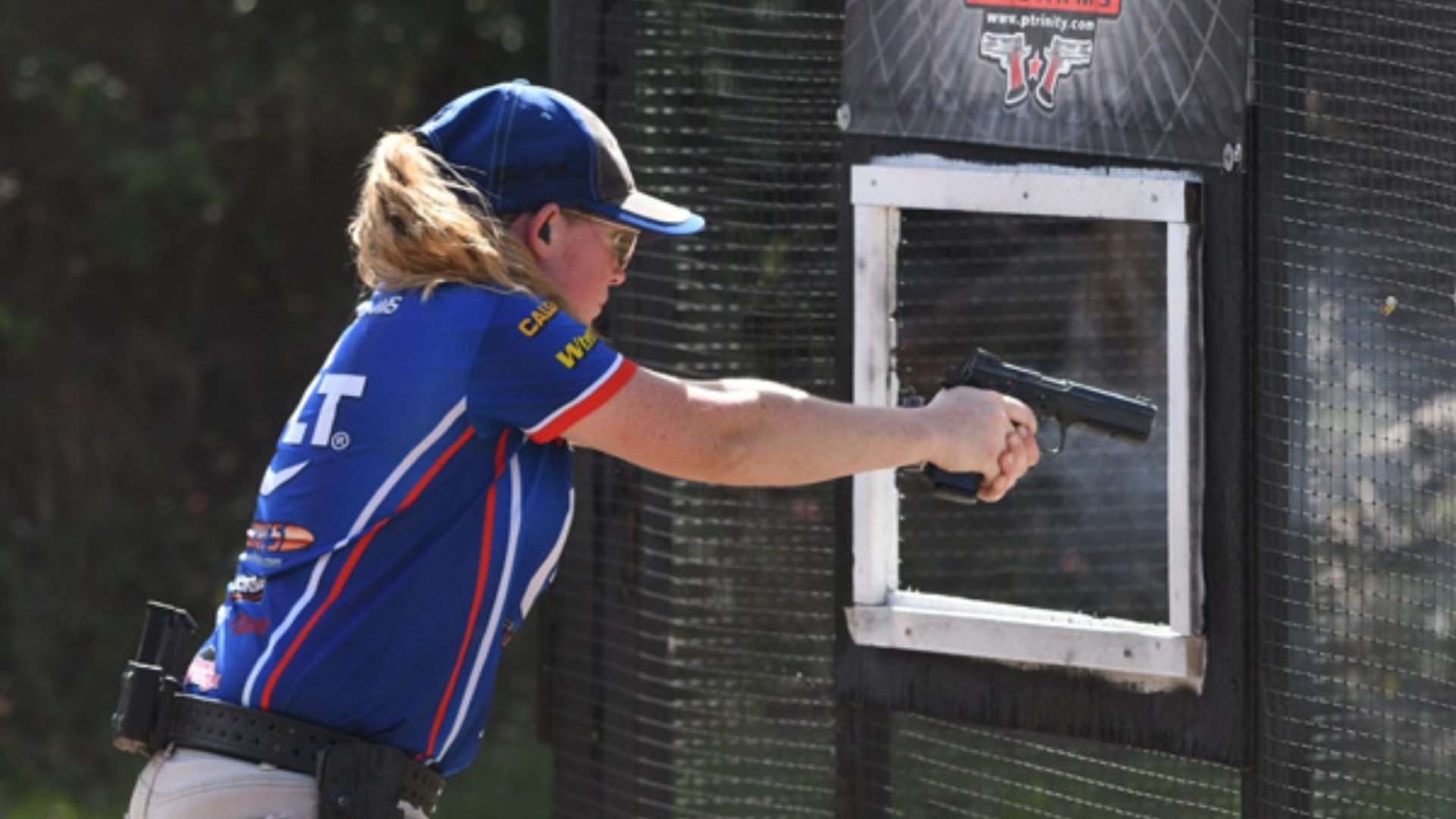
The stage that shared this bay, “Can’t You See,” was a fun Virginia Count stage that I borrowed from a previous SNS 400 Match. Stage 11 was only three targets, each with hardcover, and competitors were required to engage any target with four rounds, then hopefully stick a mandatory reload and engage the remaining two targets also with only four rounds each. Nothing to it, except for the hardcover, the reload, the no-makeup shots since it was Virginia Count—and of course the shooting. Max Michel ran it in 3.98 for another win, and Mason took another win here as well. The SIG boys were kicking it up a notch on day two, but we were only halfway through the match now and it was still anyone’s to win in both divisions.
The other doubled-up bay in this zone featured another stage that was going to be turned into a classifier. Stage 12, “Are You Experienced,” was not the stage that was originally planned and shown in the matchbook. Once we started putting the stages on the ground, it became apparent that these two stages would not fit in the same bay, so we came up with something else. We had two wall sections up, so I messed around with some target stands and made sure that we were not going to have any shoot-through issues into the other stage. What we came up with turned out to be one of the more fun, fast little IPSC-style stages that was six IPSC cardboard targets, an “unloaded on barrel” start with three wall sections and a double-stack barrel vision barrier. This little stage tripped up some folks who tried to go too fast, but it was well received.
Stage 13 “Déjà vu” had the same wall set-up and outside target presentation as Stage 5; however, the two center targets were replaced with four poppers. The steel added a new dimension to the stage by alternating big and small poppers. After a rough start on day one, Max Michel was dialed in and this would be his fifth stage win in a row. In Production, J.J. Racaza would pick up his third stage win, shooting all 60 points in 5.94 seconds, which is just a little bit slower than his 5.19 time on Stage 5 with the paper instead of the steel.
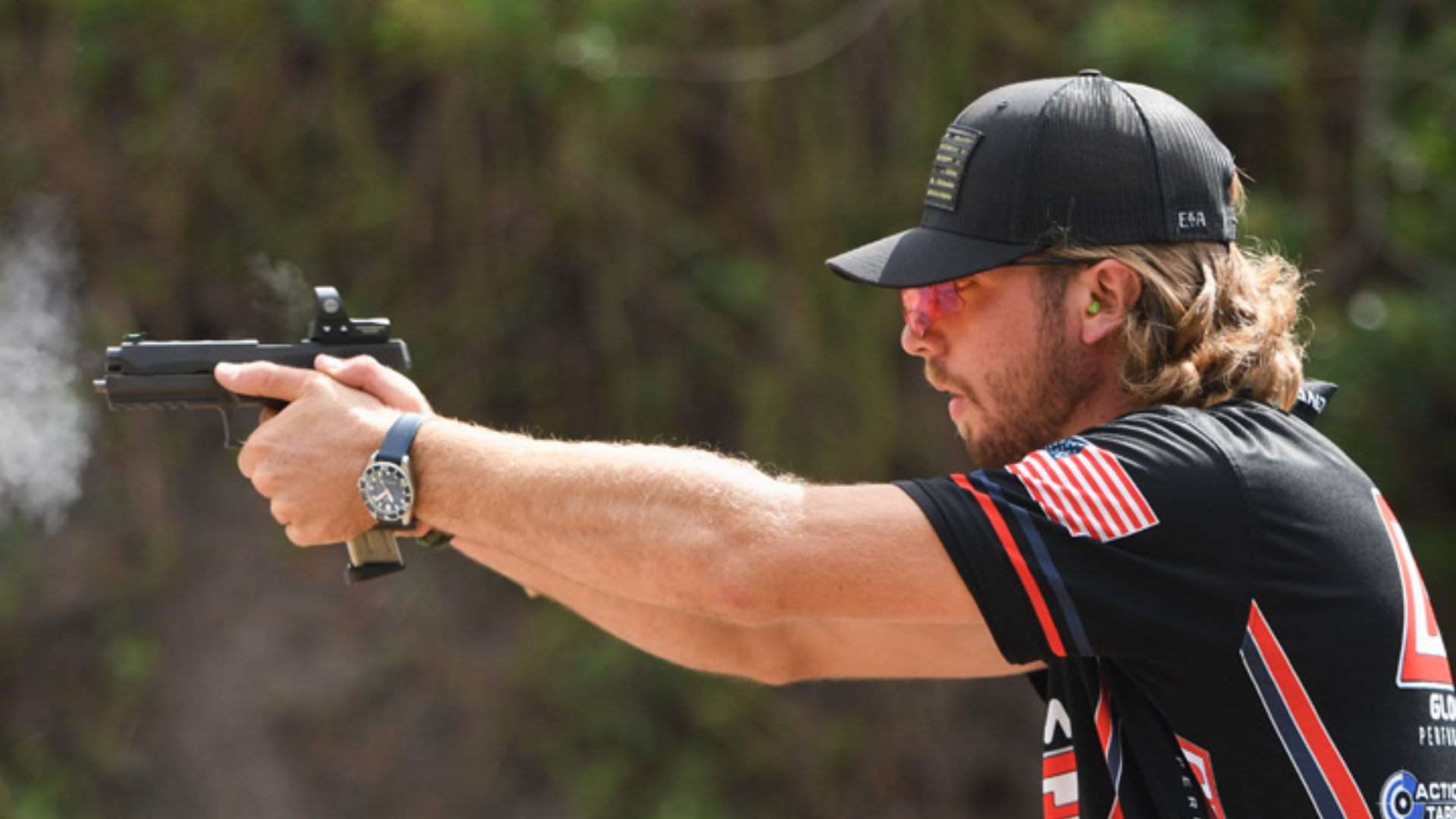
“Southbound” was the name for Stage 14, with its start position on the front fault line requiring a backup into the left or right side of the stage. There were also two ports that required targets to be shot from, as well as a swinger that was activated by a popper. Thirty-two rounds would be required for this stage that would make you change gears from close hoser targets to some cardboard with tight no-shoots, and an array of poppers spaced just far enough apart that it was easy to pull off on one or two. With the limited capacity of the Production guns, the stage plan was going to be risky running the gun empty into the last position, if you managed to go one for one on the steel. Both Michel and Racaza continued here with back-to-back stage wins.
The last stage in Zone 2, “Careless Whispers,” was Stage 15, a 20-round stage with nine USPSA targets and two poppers, one that activated a swinger. The start was again on the front forward fault line in the center of the shooting area, but competitors were going to use every corner on this one. As simple as the layout was here, it allowed for lots of options and the stage was shot many different ways. Jacob Hetherington ended the second day of shooting with a stage win on this one, and Max Michel decided to not let up on the throttle as he picked up yet another stage win.
With two days of shooting wrapped up, the competitors were anxious to get through Zone 3 which actually had the most points up for grabs, requiring 170 rounds on day three. There were only seven stages in Zone 3, but the most points on the line for the next Production and Carry Optics Champions to claim. The stages in Zone 3 were all going to test the competitors, as there were several long field courses here with lots of activated targets like on Stage 16, “I’m In the Mood.” There were two swingers and a bobber on this 30-round stage. The first swinger was to the left of the start in a very tight array of poppers through an opening; this swinger was actually a disappearing target if you wanted to skip it. In Production, the round count played into the favor of skipping but you were giving up the points if you did so, and there was a little space to stick the reload while moving to the left. Once down range the stage opened up with more poppers, one that activated the swinger and one that activated the bobber which was partially hidden by a steel barrier with just an open circle to shoot through. Mason Lane started the third day of shooting taking another stage win shooting this in 17.50 seconds for a hit factor of 8.2286, ahead of Shane Coley’s second place hit factor of 7.1277. Jay Beal also burned this stage down in Carry Optics with a stage win.
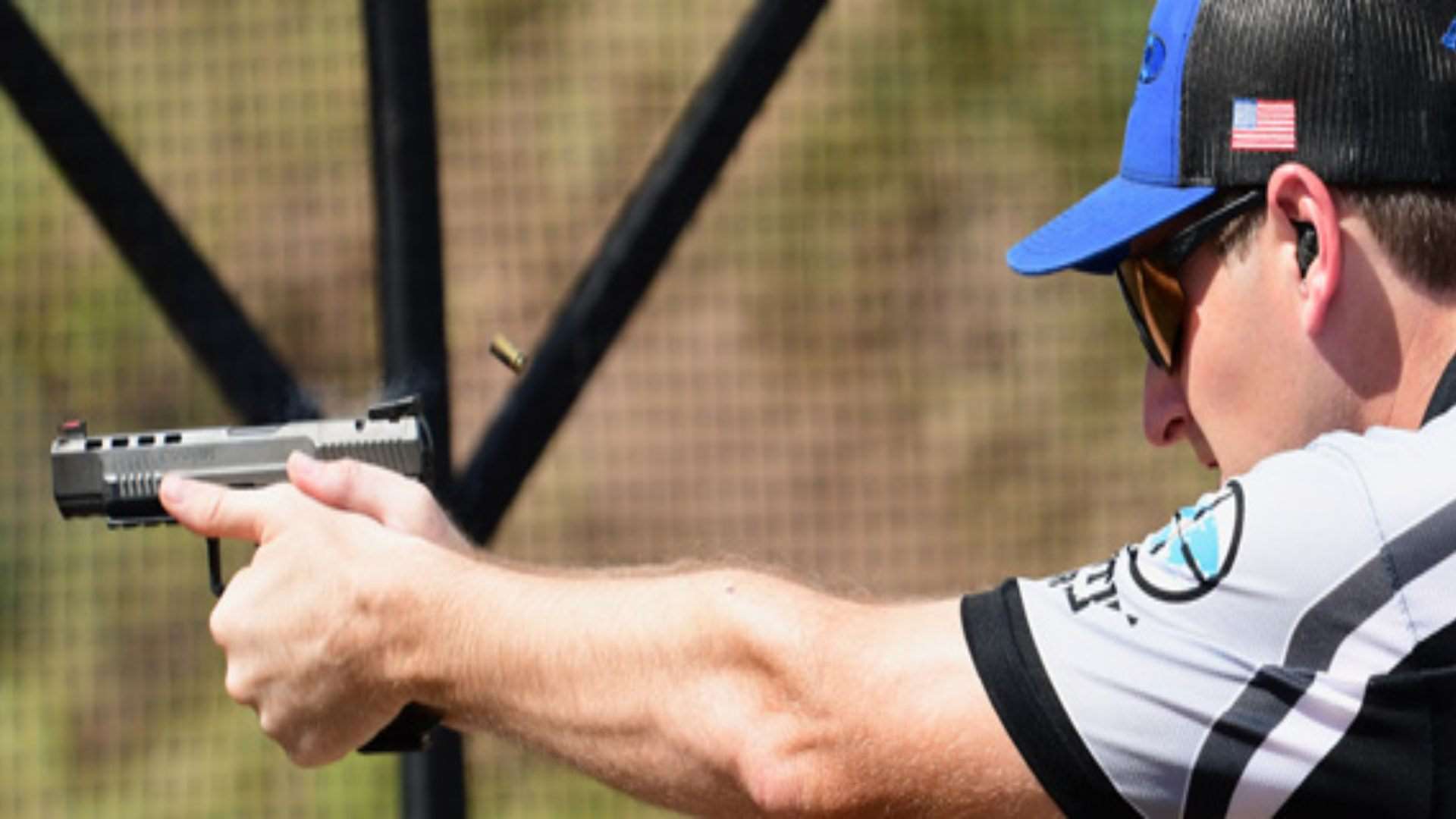
The only doubled-up bay in Zone 3 had Stages 17 and 18, which were both more of the short, IPSC-style of stages. Stage 17, “Get Back,” was a 20-round stage with IPSC targets and a rectangle-shaped shooting area that had the 10 cardboard targets laid out behind four wall vision barriers. This was another well-received stage that was trickier than it appeared. Both Phil Strader and Nils Jonasson would shoot this in one in 9.07 seconds, but Strader would take the stage win by shooting 96 points, two more than Jonasson in Production. Max Michel would start day three with a stage win as well. Stage 18 “Nothing Else Matters” was an 8-round speed shoot, with an unloaded start and a disappearing max trap target activated by either of the two mini-poppers. There were tight no shoots on the cardboard IPSC targets, and stages like this can either be awesome or a humbling, brutal experience to shoot. What looks simple, pick up the gun, load it and get to work can quickly turn into a train wreck—racking up penalties rushing the shots and picking up no-shoots, or just misses trying to stay away from the no-shoot penalties. K.C. Eusebio snagged a stage win away from Michel with a slightly slower time, but picked up one more A hit. Phil Strader crushed this stage with his SIG 320 Legion with a blistering 3.86-second run, shooting all 40 points. Even more amazing—he had called this stage win.
The Factory Gun Nationals was in the home stretch with just four stages remaining, and they were all field courses. Stage 19 “What a Fool Believes” is one that fellow Match Director Shannon Smith commented on, “This is one people will be talking about.” Universal has a large Tac Bay that I designed this stage for specifically, and Smith took the design and made it fit the bay. This was a 32-long course, and by long, I mean not just the shots but also the amount of space the shooting area ended up being. Competitors started this gauntlet of a stage with a target at 45 yards to the left and a mixture of cardboard and steel ranging from 30 yards to 10 yards, then 20 yards to the right far end of the shooting area was needed to get to the next array. Once there, competitors had a double stack of targets at 25 yards and another array of single targets at 20 yards that had to be taken from the back far right corner. Working your way forward and back to the left, you engaged a set of targets through a port before moving forward to take targets that were now visible back to the far right at 15 to 20 yards. Moving forward again to the second port opened up another array of targets and where most competitors ended this behemoth of a stage. Competitors were dealing with a lot of shooting and movement on this stage, not to mention the long-distance shots. With 160 points on the line, it was going to be a stage that could decide who was going to walk away the next division champion. It was a high disaster factor stage where being too conservative on time could cost you, as well as rushing and dropping points shooting minor certainly would. John Vlieger edged out the rest of the field in Carry Optics, shooting 150 of the 160 points in 24.77 seconds. The high-capacity magazines in CO definitely helped on this stage, allowing for make-up shots that the Production field didn’t have. Sal Luna’s 25.30-second run with 144 points took another stage win for him.
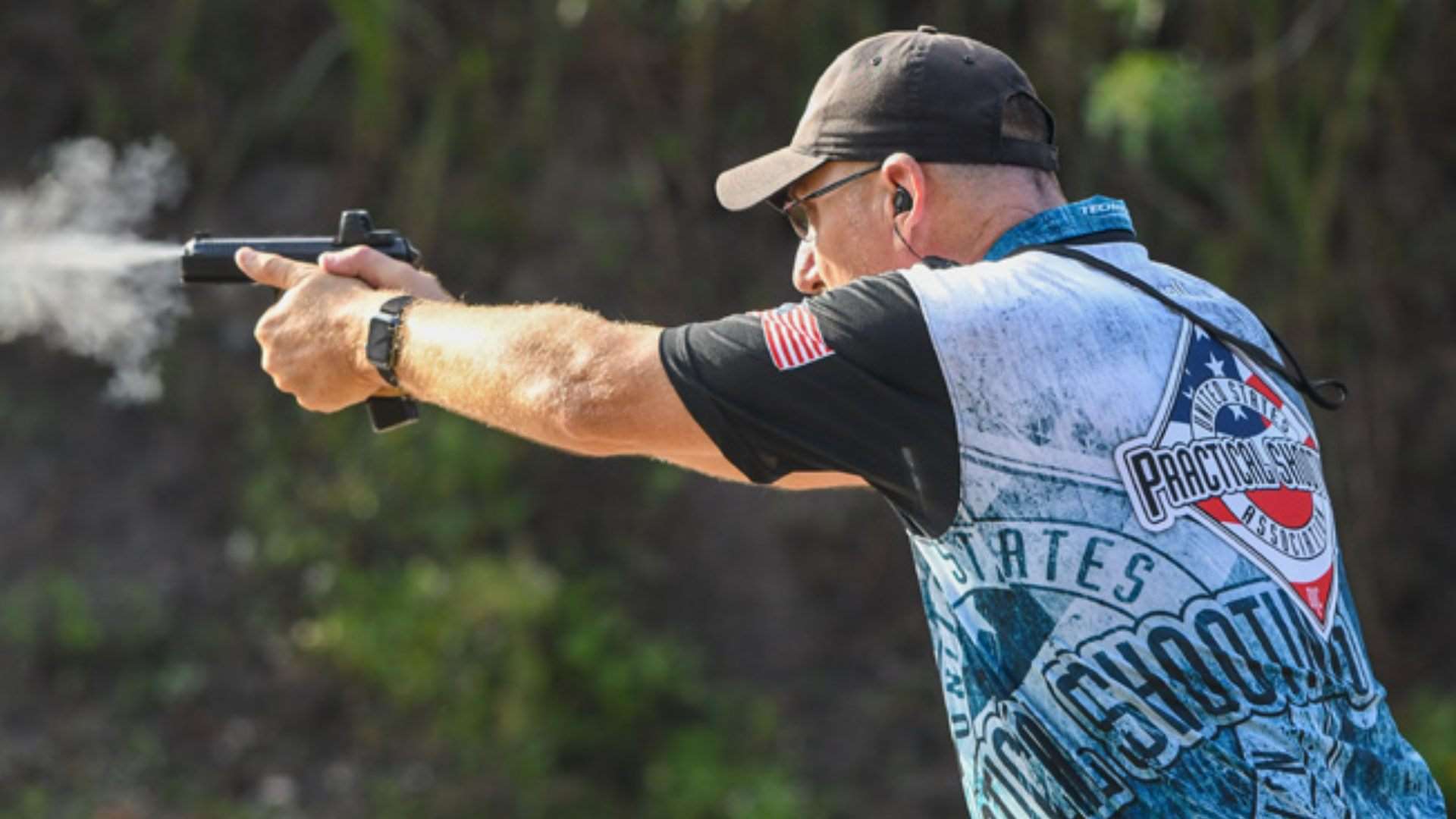
If you survived stage 19 and didn’t get lost in the Tac Bay, Stage 20 “Times Likes These” waited for the competitors as they looked to finish out the match. This 24-round stage had nine IPSC cardboard targets and six poppers spread out in the wide bay with a start position in the middle of the rear fault line. Competitors were going to use the entire shooting area, no matter if they went left or right when the buzzer went off. Each array of targets was three cardboard and two poppers; however, the center section of the stage had two targets that were only going to be visible from the right and left sides, as they were tucked back behind the wall sections. Jacob Hetherington was still battling it out with Mason Lane and Sal Luna, taking another win on this stage as did K.C. Eusebio in Carry Optics.
The second-to-last stage, “Live and Let Die,” was worth 155 points and wasn’t going to go easy for the competitors. There were several tight shots through three different ports, a swinger from the last position that was activated by one of the three poppers and several arrays of targets that would require a change in cadence when shooting, with hard cover or no-shoots sprinkled out across the bay. This was a necessary stage win for Max Michel heading to the last stage, and his 139 points in 14.02 seconds got it. Racaza was pushing on this stage with the fastest time of 15.29 in Production, shooting 145 of the 155 points.
The final stage of the match, with an appropriate title taken from the Led Zeppelin song “Good Times Bad Times,” was a 25-round stage with two swingers, three poppers, 11 cardboard targets and a forward fault line start position. There were several targets with no-shoots, and the swingers were going to test the competitor’s ability to have patience and timing to get their hits. The swingers were activated by two separate poppers and were both hidden behind the same long hard-cover vision barrier. The far-left side had only two targets, then a quick move back to the right and a stop at the port before ending on a hard lean at the far-right wall for the last four targets. Austin Ariss didn’t have the fastest time for his stage win but only dropped two points, shooting 123 of the 125 available in Carry Optics, and Nils Jonasson took this last stage win in Production with a 13.32-second run.
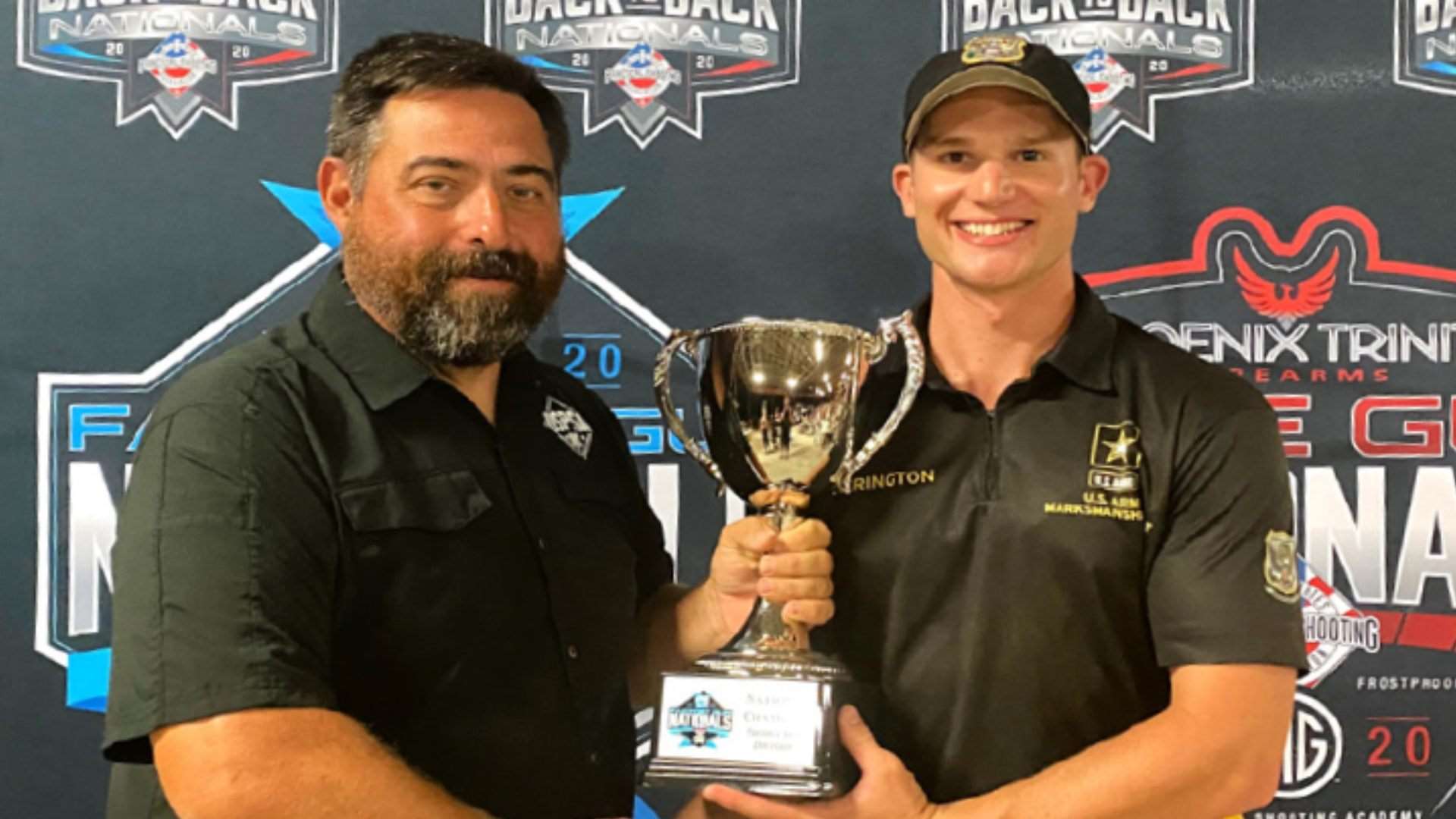
Three days of shooting, 22 stages and 488 minimum rounds for competitors at the Blue Bullets Factory Gun Nationals pushed their Production and Carry Optics guns to the limited. The stages were all straight-up shooting stages, no over-the-top props or gimmicks, only shooting challenges for the 363 who made their way to Universal Shooting Academy in Frostproof, Fla. The awards ceremony, sponsored by Visit Central Florida, was held onsite at the range with music, food and a deep prize table from the match sponsors. AMU shooter Jacob Hetherington took the podium to claim his first Production National Championship title and his second Nationals victory, having won Single Stack in 2017. Max Michel did not start off like a four-time Carry Optics Nationals Champion on day one, but was able to pull it together to claim his fifth title in this division. Michel is the only person who has won the Carry Optics title since its becoming a division in 2016. Additionally, Justine Williams claimed another Ladies National Champion in Carry Optics, while sister Jalise Williams took the Ladies title in Production division.
Article from the January/February 2021 issue of USPSA magazine. Photos by Jake Martens.
Read more: How To Schedule National Range Officers Institute Seminars














